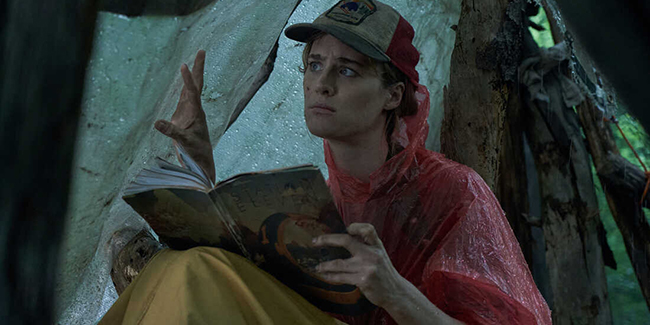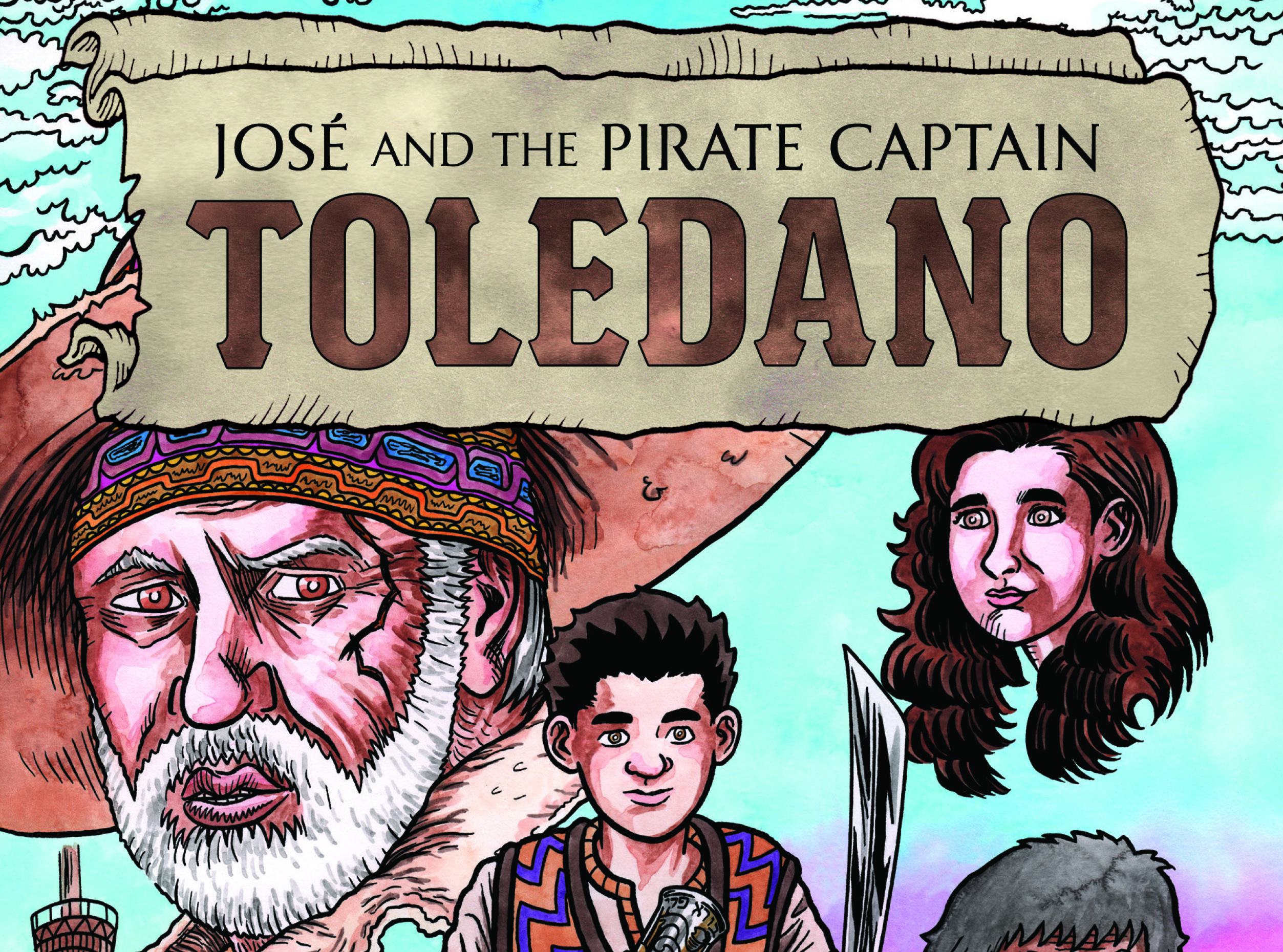
Josh Reviews Station Eleven
Station Eleven is adapted from the novel written by Emily St. John Mandel. Twenty years after a deadly flu has wiped out much of the world’s population, a small group of traveling actors and musicians make their way between the scattered remnants of humanity, performing Shakespeare at the towns and settlements they visit. As the story unfolds, we follow the lives of a disparate group of people in the days and years before and after the flu pandemic, slowly discovering the complicated ways in which their lives are intertwined with one another, and with the graphic novel called Station Eleven that was written and illustrated by the ex-wife of a Hollywood actor who had a heart attack on stage while performing King Lear on the night when the flu first struck…
I was advised by friends to read the Emily St. John Mandel’s novel before watching the show; I am very glad that I did, and I encourage you all to do the same. The novel is a masterpiece. It’s a beautiful story about art and the enduring importance of creating art even in the face of total catastrophe. It’s a compelling character study mixed with a post-apocalyptic drama/adventure. I adored Ms. Mandel’s writing style, which was humorous and gentle even when dealing with incredibly depressing subject matter. I loved the structure of the book, which intricately interwoven flashbacks and flashforwards, moving between the stories of different characters in different places and times, only gradually (and at a perfect pace) revealing how all of the pieces fit together.
The show isn’t half bad either!!
The ten-episode adaptation of Station Eleven is terrific. While it pales somewhat in comparison with the brilliant novel, the show is a marvelous adaptation of and expansion of Ms. Mandel’s story. I highly recommend it.
It’s very bizarre to be continuing to live in the midst of a pandemic (even if many people seem to want to believe that’s not the case) and to be reading a novel and then watching a TV show in which most of the world has been wiped out by a deadly pandemic. Interestingly, the novel was released in 2014, and although the show was released almost two years into the COVID pandemic, it was filmed in 2019 before the pandemic began. Certainly watching it now gives it an entirely new level of creepy resonance. (And also leads to some peculiar moments such as my anger at seeing Jeevan’s sister, a trained medical professional, remove her mask BEFORE exiting a room with a group of kids who might have been exposed to the deadly flu. I have much greater sensitivity to masking protocols after two years of COVID than I would have back in 2019!!) I found the show harder to watch than it was to read the novel. For me, these events hit much harder when watching them depicted on-screen. And yet the brilliance of the show, as was the case with the novel, is that this is not intended to be a depressing slog. Although one could argue that the story’s setting is a dystopian one, the story is life-affirming and uplifting. (It’s no accident that the novel — and, to a lesser extent, the show as well — makes numerous references to Star Trek, arguably the most famous utopian science-fiction story/franchise ever.) This is what I love about both the book and the show — this is not a story about death, it’s a story about life, of about how thoroughly our lives are interconnected with that of the other human beings around us, and of how powerfully our actions can impact others. This is a beautiful hook for the story being told, and it is delightfully well-executed in both the show and the novel.
A ten-episode mini-series is the perfect format for this adaptation. I was impressed by how skillfully show-runner Patrick Somerville and his team were able to break this story apart into ten episodes, each of which felt satisfying and complete while also fitting together beautifully as a whole. I loved that they didn’t feel the need to squeeze every main character into every single episode. Instead, they allowed individual episodes to focus on certain characters and time-periods, allowing us to be immersed in their experiences without having to constantly cut back to check in with the other regular characters. This is a perfect way to bring to life the novel’s onion-like narrative structure, and to develop the large cast of characters, each of whom has important backstory to be explored. Many other streaming shows could learn a lesson for how carefully balanced this ten-episode season is structured.
The series is a very faithful adaptation of the novel, while at the same time Mr. Somerville & co. clearly felt free (rightly so) to make many changes. I must admit that while watching the first half of the series, I questioned some of the choices. Time and again, the show seemed to take characters who I’d loved in the novel and portrayed them as more flawed and less likable. Jeevan still rushes onstage after Arthur collapses, but in the show he’s not able to actually help, revealing he doesn’t have any medical training. Kirsten’s stabbing of the Prophet in episode two struck me as unwarranted and shockingly cold-blooded… and I was surprised that the capable Kirsten also failed to actually kill him. (That seemed like a silly television twist to me.) Clark seems far more self-centered and obnoxious than he was in the book, and his Museum of Civilization plays as self-aggrandizing, while in the book I thought it had a solemn sort of nobility. Elizabeth is incredibly mean when Clark tries to talk to her on the plane. I could go on. But while any divergences from a book I loved stood out to me, I freely admit that in the end I felt the show’s storytelling decisions worked well. Indeed, the show makes some choices that I thought were brilliant. I’ll highlight two. First, I loved that the show depicted Kirsten and Jeevan’s as sticking together for the entire first year of the flu, as opposed to their just having met on that first night as in the book. That was a wonderful choice that led to many amazing moments between Jeevan and Kirsten, and it paid off in a deeply moving moment at the end. When I re-read the novel I know I’ll miss that aspect of the story! Second, I loved the very different way in which the Prophet’s story ended on the show. While I had some questions along the way (I still cannot buy that Kirsten would have had anything to do with him after having seen him use children as suicide bombers), the ultimate climax of his story was deeply moving and wonderfully enhanced the story’s hopeful, life-affirming core.
I’d wondered how the show would handle depicting the Station Eleven graphic novel — so central to the story — visually on-screen. I loved the way this played out. I loved the many times the camera lingered on pages of the book (bravo to the illustrator(s) who brought that to life), and I also loved the way the show used the image of a figure in an opaque-helmeted space-suit as a recurring vision for multiple characters throughout the story. (In my mind the show only made one misstep, which was attributing the Traveling Symphony’s motto — “survival is insufficient” — to a line in the Station Eleven graphic novel. Ms. Mandel’s novel correctly attributes that line to Star Trek. We know that Star Trek exists in the world of the show — we see young Kirsten watching a Star Trek episode in the very same episode in which they said that line came from the Station Eleven graphic novel — so, what, are we to assume that Miranda ripped off Star Trek?? Obviously the show’s writers just used that as a narrative shortcut and were hoping the audience wouldn’t notice — but this Star Trek fan certainly did!)
I also loved how thoroughly Shakespeare — and, specifically, Hamlet — was woven into the show. This was an important aspect of the novel, and I think the show actually one-upped the novel in how skillfully and intricately the story of Hamlet was woven into the story of the show. It all culminates in that brilliant and heartbreaking sequence in which the Prophet performs Hamlet along with members of the Traveling Symphony in the finale. I was deeply moved, and struck by how well the show was able to emphasize the continued relevance and power of Shakespeare’s work (something in which we know the members of the Traveling Symphony — well, at least most of them — deeply believe).
The show’s cast is incredible. I was very pleased to see such a diverse cast assembled to bring this story to life. The ensemble is headed up by Mackenzie Davis (The Martian, Blade Runner 2049, the “San Junipero” episode of Black Mirror), who is mesmerizing as Kirsten. Ms. Davis is soulful and gripping in her portrayal of this strong but deeply wounded young woman. Matilda Lawler is extraordinary as young Kirsten; what expressive eyes she has! This is an incredible performance for an actress who is so young. I suspect Ms. Lawler has a wonderful career ahead of her. Himesh Patel (Avenue 5, Don’t Look Up) is terrific as Jeevan Chaudhary, an anxiety-prone young man who winds up taking care of young Kirsten after the flu hits. I knew Mr. Patel could be very funny, but I’d never before seen him deliver such a layered, emotional dramatic performance. Nabhaan Rizwan is every bit as great as Jeevan’s brother, Frank. David Wilmot takes us on quite a journey as Clark; I love his fearlessness in allowing us to see Clark’s flaws. Gael García Bernal does strong work as the Arthur Leander (though I must confess that while I think Mr. Bernal is a brilliant actor, I couldn’t shake the feeling that he was miscast as Arthur. He seemed too young, and not nearly damaged enough in the critical scenes at the end of Arthur’s life, just as the flu is hitting). Daniel Zovatto is incredibly creepy and memorable as the mysterious Prophet. Lori Petty (Orange is the New Black) makes a strong impression in not too many scenes as the Traveling Symphony’s conductor, Sarah. Danielle Deadwyler (so memorable as Cuffee in The Harder They Fall) is wonderfully dignified and nuanced as Miranda Carroll. (I loved her final scenes in the show and the revelation of the critical role she played in keeping the people at the airport safe. That was another great change the show made! It answered a lingering question I had from the book, which is what prevented the passengers of the doomed Gitchegumee Air flight 452 from breaking out of the plane and making a run for it.) I haven’t even mentioned David Cross, Enrico Colantoni (Galaxy Quest), Caitlin FitzGerald as Elizabeth, Philippine Velge as Alexandra, and so many other wonderful actors who bring to life the members of the Traveling Symphony and the other people they encounter. There really isn’t a weak link.
I highly recommend this beautiful show. Bring a couple of tissues, though, as your eyes might get a little misty at points; mine certainly did…
Click here to pre-order my graphic novel José and the Pirate Captain Toledano!
Click here to purchase my “Maclunkey” Star Wars/Highlander mash-up t-shirt!
Please support MotionPicturesComics.com by clicking through one of our Amazon links the next time you need to shop! As an Amazon Associate, I earn from qualifying purchases. That means I’ll receive a small percentage from any product you purchase from Amazon within 24 hours after clicking through. Thank you!


